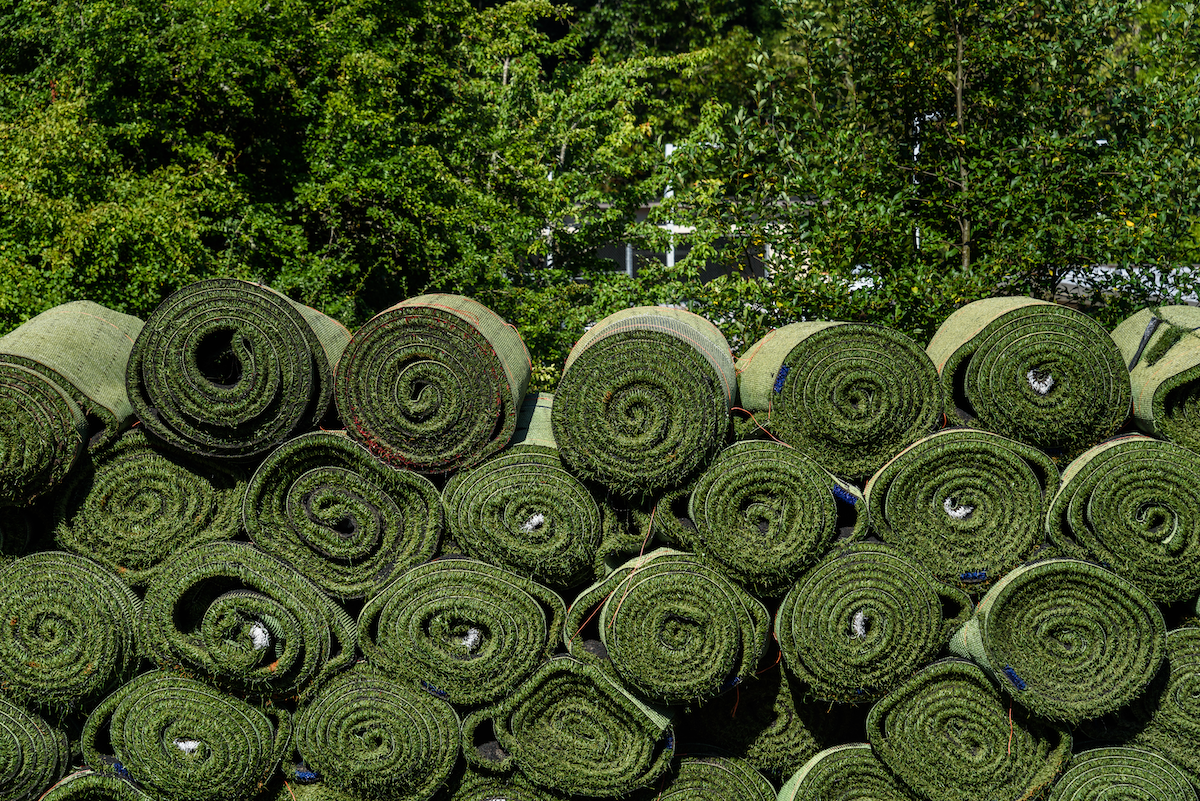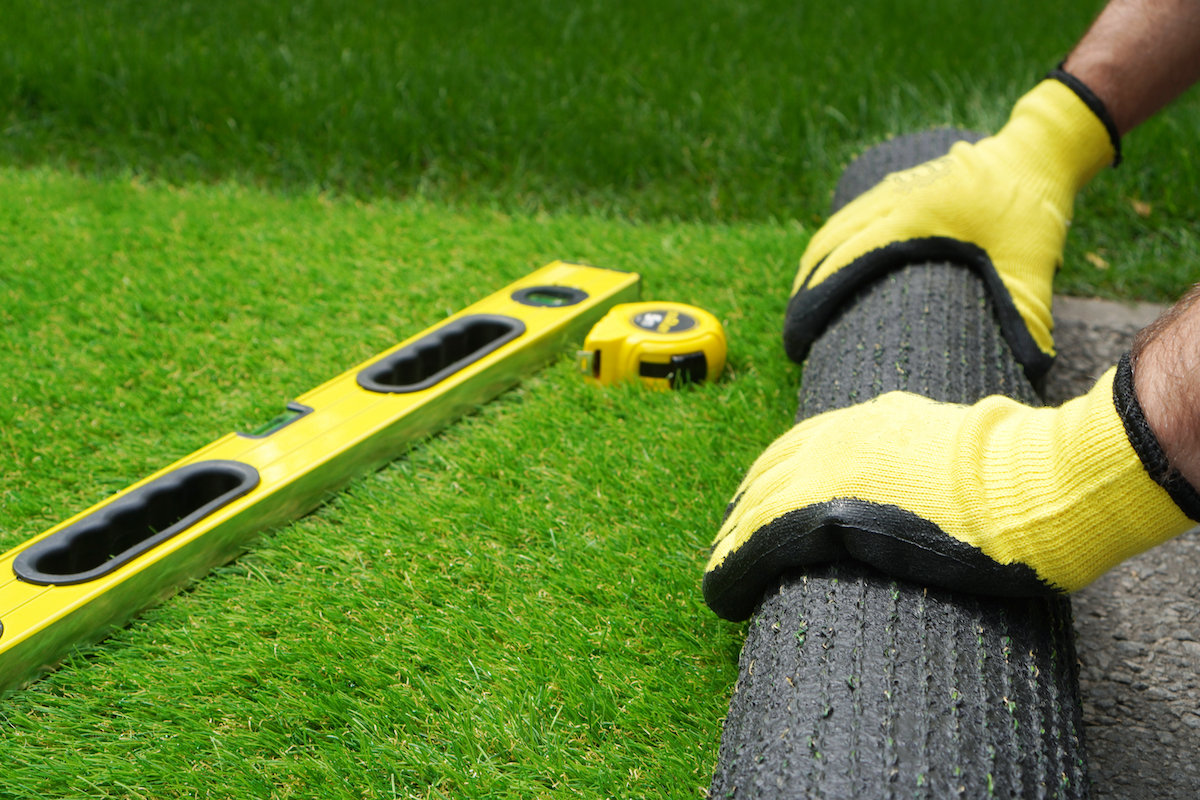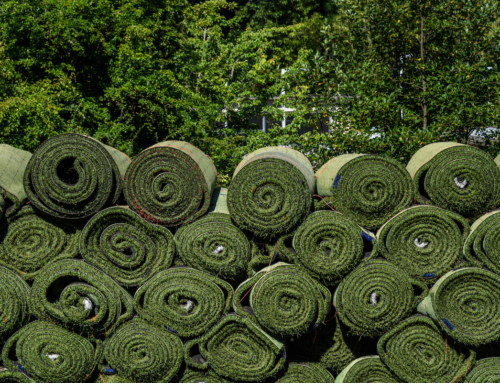Last Updated on February 27, 2024 by ReTurf
When considering landscaping options, artificial turf is often recognized for its low maintenance and year-round green appearance. Yet, when it comes to the area around trees, the conversation takes a slightly different turn. Here, the use of artificial turf isn’t just about keeping the lawn looking neat without the constant mowing and watering. It’s also about protecting the trees themselves. The concept of artificial turf as a tree skirt does more than just add a touch of greenery; it plays a crucial role in safeguarding the tree roots underneath.
Trees are an essential part of any garden, offering shade, beauty, and sometimes even fruit. Their roots, however, are susceptible to various stresses, including foot traffic, temperature fluctuations, and erosion. These can all be mitigated with the strategic use of artificial turf. By acting as a barrier, artificial turf helps in maintaining soil moisture and temperature, reducing erosion, and minimizing physical damage to roots.
This approach marries the aesthetic appeal of a well-kept, green space with the practical benefits of root protection. It’s a thoughtful way to ensure that the trees, which are often the centerpiece of a garden, remain healthy and strong. The following sections will delve deeper into the hows and whys of installing artificial turf around trees, making sure the benefits are maximized without compromising the health and growth of these natural giants.
Tree Health and Artificial Turf Benefits
Understanding how artificial turf benefits tree health involves looking at the practical aspects of their interaction. The installation of artificial turf around trees, commonly referred to as tree skirts, offers a protective layer that significantly contributes to the health and stability of trees, especially focusing on their roots.
One of the primary advantages of using artificial turf is its role in reducing soil erosion. Under natural conditions, heavy rainfall can wash away the soil around tree roots, which destabilizes the tree and deprives it of nutrients. Artificial turf acts as an anchor for the soil, keeping it in place, which in turn supports the tree’s nutritional uptake and stability.
Temperature regulation is another critical benefit. Extreme temperatures, both hot and cold, can stress tree roots and affect their function. Artificial turf provides an insulating layer, moderating the soil temperature around the roots. This consistent environment allows the tree to focus on growth rather than survival, making it more resilient to weather changes.

Foot traffic can compact soil and damage tree roots, a common issue in landscaped areas. The cushioning effect of artificial turf protects the roots from this kind of stress, ensuring they remain healthy and unharmed. This protection is particularly important in high-traffic areas, where the constant pressure could otherwise compact the soil too much, making it hard for roots to breathe and absorb water.
The notion that artificial turf blocks water and air from reaching the roots isn’t entirely accurate. Modern artificial turfs are designed with permeability in mind. They allow water and air to pass through, ensuring that roots receive the necessary nutrients and hydration. This design addresses one of the main concerns about artificial turf, ensuring that it supports rather than hinders tree health.
Artificial turf offers a multifaceted approach to protecting and promoting tree health. By preventing erosion, regulating temperature, providing a buffer against physical damage, and allowing essential water and air to reach the roots, artificial turf serves as a valuable ally in maintaining the vitality of trees.
Assessing Your Landscape for Turf Skirts
Before jumping into installing artificial turf around your trees, it pays to do a bit of groundwork. Not all landscapes or tree types will equally benefit from turf skirts, so understanding your garden’s specific needs is crucial. This section will guide you through evaluating your landscape to ensure that artificial turf skirts are a good fit.
Start by considering the tree species in your landscape. Different trees have varying root systems; some are deep-rooted, while others have roots closer to the soil surface. Surface-rooted trees can particularly benefit from the protective qualities of artificial turf, as it helps shield the roots from physical damage and extreme temperature changes. Knowing your trees’ root behaviors will help you decide where artificial turf might be most beneficial.
Soil conditions play a significant role as well. Artificial turf has excellent drainage capabilities, but if your soil is particularly prone to retaining water, adding a layer of turf could exacerbate the issue, leading to waterlogged conditions that could harm the tree. On the flip side, in areas where soil erosion is a concern, artificial turf can provide a stabilizing effect, protecting the soil (and thereby the roots) from being washed away.
Lastly, consider the overall needs of your landscape. Are there areas with high foot traffic that could benefit from the durability of artificial turf? Or perhaps parts of your garden struggle to sustain natural grass due to shade or soil quality, making artificial turf a more visually appealing and practical option.
By taking the time to assess the specific needs of your trees and the conditions of your landscape, you can make an informed decision about integrating artificial turf skirts. This ensures not just the aesthetic enhancement of your garden but also the health and longevity of your trees.
Selecting Suitable Artificial Turf
Choosing the right artificial turf for your landscape, especially around trees, involves more than just picking out the best-looking sample. It’s about finding a balance between aesthetics and functionality, ensuring that the turf you select contributes positively to the health of your trees and the overall environment of your garden.
The first thing to consider is permeability. A turf that allows water and air to pass through freely is crucial. This ensures that tree roots receive necessary hydration and aeration, promoting healthy growth beneath the surface. Look for products specifically designed with a breathable backing material to facilitate this.
Durability is another key factor. The area around trees can be a high-traffic zone, and the turf needs to withstand this without wearing down or compacting the soil too much. A durable turf maintains its integrity over time, offering continuous protection for the roots against physical damage from foot traffic and garden equipment.
Environmental compatibility is also essential. Opt for turf made from eco-friendly materials that are non-toxic and safe for the surrounding flora and fauna. Some artificial turfs are made from recycled materials, which can be a great way to contribute to sustainability in your landscaping efforts.
When selecting artificial turf, consider these characteristics carefully. The right turf will not only enhance the beauty of your landscape but also play a vital role in maintaining the health and stability of your trees.
Preparation for Installing Artificial Turf Skirts
The key to successfully installing artificial turf around trees begins with thoughtful preparation. The first step involves carefully clearing the area around the tree. It’s crucial to remove any weeds, stones, or debris that could interfere with the turf’s placement without disturbing the tree’s roots. Minimizing root disturbance is essential to maintain the tree’s health and stability.
After clearing, assessing the soil condition is next. The goal is to ensure that the turf’s base allows for adequate water and nutrient flow to the roots. In some cases, amending the soil with sand or a similar material can improve drainage and create a stable base for the turf. It’s also important to level the ground gently to avoid creating low spots where water could collect.
Cutting the turf to fit around the tree is a delicate task. Leave ample space around the trunk to accommodate growth and ensure there’s no pressure on the tree bark. This space is vital for the tree’s expansion and prevents any constriction that could harm its development.
This preparation phase lays the groundwork for a successful turf installation that harmonizes with the tree’s needs, ensuring both the artificial turf and the tree coexist beneficially.

Installation Techniques and Root Protection Strategies
Installing artificial turf around trees with an eye towards protecting the roots and ensuring the tree remains healthy involves careful planning and execution. The process begins with measuring and cutting the turf accurately. This ensures it fits around the tree trunk without being too tight, providing enough space for the tree to grow. A gap of at least a couple of inches around the trunk is recommended to avoid any pressure on the tree itself.
When laying the turf, it’s essential to consider the root system beneath. The turf should never be laid in a way that compresses the roots or restricts water and air flow. One technique is to use a flexible border or edging around the tree before laying the turf. This edging can help maintain a gap around the trunk and also serve as a guide for cutting the turf with precision.
The choice of infill material plays a significant role in protecting the tree’s roots. Using a permeable, breathable infill ensures that water and nutrients can reach the soil underneath the turf. This is crucial for maintaining the tree’s health. Non-absorbent, fine-grained infill materials can facilitate a healthy exchange of water and nutrients without compacting over time.
For areas with extensive root systems near the surface, installing a protective mesh or fabric between the roots and the turf base can prevent root damage during and after installation. This layer acts as a buffer, reducing the risk of roots being cut or compressed by the weight of the turf and its usage.
Careful attention should be paid to the installation process itself. Avoid heavy machinery that could compact the soil around the tree’s roots. Hand tools and gentle techniques are preferred to minimize any disturbance to the existing root system. The goal is to integrate the turf seamlessly with the natural environment, ensuring the tree continues to thrive alongside this new addition to the landscape.
By following these strategies, homeowners and landscapers can create a visually appealing and tree-friendly installation that promotes a healthy living environment for both the turf and the trees.

Maintenance for Long-Term Tree and Turf Health
Maintaining the balance between the health of artificial turf and the trees it surrounds involves regular upkeep and vigilance. The key to longevity for both is in the routine. Cleaning the turf to remove debris, dust, and other materials that can accumulate over time is essential. This not only keeps the area looking neat but also ensures that the turf’s drainage system remains effective, preventing water from pooling and creating potential root issues for the tree.
Regular inspections play a crucial role in the maintenance routine. Checking the area around the tree, especially where the turf meets the trunk, helps in identifying any signs of compression or restricted growth. As trees grow, their trunks widen, and their roots expand. This natural growth can necessitate adjustments to the turf, such as trimming back sections to accommodate increased trunk size or to relieve pressure on the roots.
Another aspect of maintenance involves ensuring that the turf does not interfere with the tree’s access to water and nutrients. Periodically lifting sections of the turf to check the soil moisture and health of the roots can provide insights into whether any adjustments are needed in the care routine, such as increasing watering frequency or modifying the infill to improve permeability.
Environmental Considerations and Sustainability
Choosing artificial turf as a landscaping option around trees comes with its set of environmental considerations. While the aesthetic appeal and practical benefits, such as reduced soil erosion and consistent ground cover, are clear, it’s important to weigh these against the overall impact on the garden ecosystem.
One of the main environmental benefits is the reduction in water usage. Unlike natural grass, artificial turf does not require regular watering, which can contribute to water conservation efforts. However, it’s essential to select turf materials that are environmentally friendly and recyclable, minimizing the ecological footprint of the installation.
The impact on local wildlife and the garden’s biodiversity is another factor to consider. Ensuring that the selected turf and installation methods do not harm the existing ecosystem is crucial. Options that allow for water and air to permeate effectively can help maintain soil health beneath the turf, supporting the microorganisms and insects that contribute to a healthy garden environment.



